

 | |
 | |
| Clinical data | |
|---|---|
| Other names | Oxymorphone hydrazone |
| ATC code |
|
| Identifiers | |
| |
| CAS Number | |
| PubChem CID | |
| ChemSpider | |
| UNII | |
| Chemical and physical data | |
| Formula | C17H21N3O3 |
| Molar mass | 315.373 g·mol−1 |
| 3D model (JSmol) | |
| |
| |
| (verify) | |
Oxymorphazone is an opioid analgesic drug related to oxymorphone. Oxymorphazone is a potent and long acting μ-opioid agonist which binds irreversibly to the receptor, forming a covalent bond which prevents it from detaching once bound.[1][2] This gives it an unusual pharmacological profile, and while oxymorphazone is only around half the potency of oxymorphone, with higher doses the analgesic effect becomes extremely long lasting, with a duration of up to 48 hours.[3] However, tolerance to analgesia develops rapidly with repeated doses,[4][5][6] as chronically activated opioid receptors are rapidly internalisedbyβ-arrestins, similar to the results of non-covalent binding by repeated doses of agonists with extremely high binding affinity such as lofentanil.[7][8]